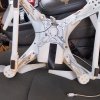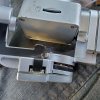Hello
With out wanting to seem hasty can I suggest two 'lessons' that are best looked at before you even get off the ground.
1) Stopping the motors when the drone is still, which normally means upright, on the ground and sitting on its landing gear. To do this, move to fully down, its '6 o'clock' position, ONLY the throttle joystick i.e. fully 'close' the throttle. Hold the joystick there until the motors stop. DO NOT touch/move the other joystick, which should be centred, during this 'routine' shut down process.
2) Stopping the motors in an emergency, if you crash or flip the drone etc. and it is tilted or upside down on the ground BE WARNED, use the "CSC" command (page 46 of the pdf manual available at
https://dl.djicdn.com/downloads/phantom_3/User Manual/Phantom_3_Professional_User_Manual_v1.8_en.pdf) to shut the motors down BEFORE trying to pick the drone up. If the props were obstructed the motors may start up once the obstruction is removed. The props are effective knives. The CSC command needs to be held for around 5 seconds to work, also be aware the CSC command can stop the motors with the drone in mid air.
It is worth noting that holding the throttle fully closed WILL NOT stop the motors if the drone is in flight. The drone must be still for it to work and there is enough movement even in a vertical descent to prevent the motors from being stopped.
DO NOT try to practice the CSC command with the drone sat, upright, on the ground with the props on and running, it can cause the drone to flip, hence using method 1 above.
You can practise both methods with the props off, the drone will warn you that you have a loose prop etc., but don't leave the motors running for long. The motors and the drone probably rely on airflow for cooling and there will be no airflow with no props fitted. For the same reason I wouldn't try a large number of 'propless' shut downs in any one session, when I have done this I doubt I exceeded 10 shut downs in any session and I doubt that the motors ran for more than 10 seconds in any one experiment.







